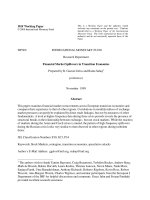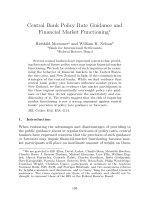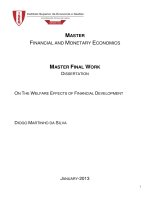ECONOMIC AND FINANCIAL MARKET OUTLOOK 2013 doc
Bạn đang xem bản rút gọn của tài liệu. Xem và tải ngay bản đầy đủ của tài liệu tại đây (155.94 KB, 10 trang )
Craig Wright
Chief Economist
416-974-7457
Dawn Desjardins
Assistant Chief Economist
416-974-6919
Paul Ferley
Assistant Chief Economist
416-974-7231
Nathan Janzen
Economist
416-974-0579
ECONOMIC AND FINANCIAL MARKET OUTLOOK
March 2013
From stall speed to cruising speed
Global policymakers pull together to bolster growth
Globally, policymakers are focused on returning the world economy to a
firmer growth path in 2013. Both central banks and governments put in place
policies that further reduced the risks of a severe downturn this year. The In-
ternational Monetary Fund (IMF) acknowledged that the degree and timing of
the implementation of harsh fiscal austerity measures were exerting greater
than expected weight on the economies of the most indebted European coun-
tries, thereby easing the pressure on governments to implement further aggres-
sive action. The Japanese government’s call for both fiscal policy stimulus and
more quantitative easing and reaccelerating activity in China also served to
reduce the downside risks to the outlook for the global economy.
Reduced tail risks ≠ guaranteed stronger growth
Despite all the constructive policy announcements, the global economy is
headed for another year of mediocre growth in 2013. Persistent uncertainty
about US fiscal issues, unease about Europe’s ability to absorb further fiscal
cutbacks, even if tempered, and political risks are some of the factors that will
likely limit the pace of expansion in the developed countries to just 1.4% this
year. Emerging economies are expected to grow by 5.5% thereby resulting in
global growth coming in at 3.5% with 2014 expected to deliver a stronger
4.1% gain.
Will this year be different?
For the past two years, forecasters were heartened by strong reports early in
the year and projected a broad-based strengthening in economic activity only
to be disappointed by global events. Tracking the composite global purchasing
managers’ index since 2010 highlights that the index peaked in February or
April and then declined as serious downside risks to key players in the global
economy materialized. It is for this reason, that we remain cautious about
reading too much into the recent improvement in the global Purchasing Man-
agers’ Indexes (PMI). Having said that, many of the more significant down-
side risks to growth have eased, and with central banks committed to keep
interest rates low, the underpinnings are in place for the second half of 2013 to
mark the beginning of a sustained period of above-trend growth for the world
economy.
US economy – three weights on growth ease, one lingers
We can point to four factors that contributed to the US economy’s half-hearted
economic expansion. The first three—household balance sheet deleveraging,
-12
-10
-8
-6
-4
-2
2
4
6
8
2008 2009 2010 2011 2012 2013 2014
Annual Grow th Rates
% change, year-over-year
Advanced versus emerging economies GDP growth
Source: International Monetary Fund, RBC Economics Research Forecasts
2012
1.3
5.2
3.2
Advanced Economies
Emerging and Dev eloping
World
2013f
1.4
5.5
3.5
2014f
2.2
5.9
4.1
Forecast
46
48
50
52
54
56
58
60
Jan/2010
Mar/2010
May/2010
Jul/2010
Sep/2010
Nov/2010
Jan/2011
Mar/2011
May/2011
Jul/2011
Sep/2011
Nov/2011
Jan/2012
Mar/2012
May/2012
Jul/2012
Sep/2012
Nov/2012
Jan/2013
SA, 50+=Expansion
Global PMI: Composite Output
Source: JP Morgan, Markit, RBC Economics Research
Arab spring &
Japan tsunami
Debt ceiling
standoff
European
soverign
debt crisis
Peak: FebruaryPeak: April
"Grexit"
fear
China
slowdown
Peak: February
2
the housing market correction, and financial market crisis—have improved
materially. The final obstacle, the outlook for the implementation of fiscal
restraint, is still weighing on confidence and growth. Our forecast had as-
sumed that there would be tax hikes and expenditure cuts this year that would
lower growth by about a percentage point. If full sequestration goes ahead as
planned, however, the restraint to growth will increase by another one-half
percentage point. Looking forward, uncertainty about the passage of the debt
ceiling legislation needed for the government to keep issuing debt on May 19
will keep attention on politics and is to likely to deter a sharp acceleration in
spending by consumers or businesses in the first half of the year.
On the plus side, households have much less to worry about with respect to the
state of their balance sheets and face improved prospects for their real estate
holdings. As of the end of 2012, US households recovered 92% of the $16
trillion of net wealth losses incurred during the recession, the debt-to-income
ratio fell by 26 percentage points, and owners’ equity in real estate rebounded
to 47% from the recent low of 37% albeit well below the 60% recorded before
the economic and housing market downturn. The downturn in the housing
market ended in 2012 with housing starts up 28% from 2011, existing and new
home sales rising 9.6%, and the Core Logic measure of house prices recording
a gain of 3.5%. As a result, real residential investment contributed 0.3 percent-
age points to 2012’s 2.2% growth rate, which was the first year of support
since 2005.
The financial system has also shown signs of renewed activity with both the
supply and demand for credit picking up. Lending standards, according to the
Federal Reserve’s Senior Loans’ Officer Survey, continued to ease for com-
mercial and industrial and non-residential construction loans in early 2013.
Loans for commercial real estate increased by 0.5% in 2012 following three
years of decline, and the volume of commercial and industrial loans rose at the
fastest pace since 2008. Against a backdrop of low interest rates and readily
available capital, we project that business investment will continue with the
focus shifting to non-residential real estate investment from capital goods pur-
chases.
U.S. real GDP: weak in Q4-2012 but details not so bad
The first read of US real GDP in the fourth quarter of 2012 was a decline of
0.1%, thereby defying forecasts for a moderate, but still positive, print. The
second estimate showed that the US economy grew at a paltry 0.1% pace.
While the headline growth rate revived talk of the US economy heading into
another recession, the details of the report suggest that these prognostications
were unfounded. Real sales to private domestic purchasers—consumers and
businesses—grew at a 3.5% annualized pace in the quarter, which was the
quickest increase since the first quarter of 2012. The weakness in the report
was due to a sharp 22% drop in government spending on defence and an ag-
gressive trimming of inventory levels. Together, these components clipped 2.9
percentage points from the quarterly growth rate. The pull back in spending on
defence was likely in anticipation of the implementation of the sequestration
on January 1. With the US$85 billion of spending cuts delayed until March 1,
-75
-50
-25
25
50
2001 2002 2003 2004 2005 2006 2007 2008 2009 2010 2011 2012 2013
Commercial Real Estate
C&I Loans to Large Firms
%
FRB Senior Loan Officer Opinion Survey: Reporting Stronger Demand
Source: Federal Reserve, RBC Economics Research
-10
-8
-6
-4
-2
0
2
4
6
8
10
2000 2001 2002 2003 2004 2005 2006 2007 2008 2009 2010 2011 2012 2013 2014
Source: Bureau of Economic Analysis, RBC Economics Research
U.S. real GDP
Quarter-over-quarter annualized % change
Forecasted Values:
Annual Growth Rates
2012
2.2Real GDP
2013f
2.0
2014f
2.9
40
45
50
55
60
65
70
2002 2003 2004 2005 2006 2007 2008 2009 2010 2011 2012
$ trillions
U.S. net wealth
Source: Federal Reserve, RBC Economics Research Forecasts
3
the government’s pre-emptive spending cuts in late 2012 set up for the quar-
terly pace of declines in government spending to be more muted in 2013.
Receding risks to global outlook …
It is not only uncertainty associated with the US fiscal landscape that will limit
activity in the first half of 2013 but also concerns about the depth and duration
of the European recession. The sharp drop in real GDP in the euro area in the
fourth quarter of 2012 reflected a broad-based decline in activity across the
region. In early 2013, political issues are likely to temper spending in some of
the key economies thereby resulting in another quarterly drop in real GDP.
Likely, the headline decline will mask a rebound in Germany though this will
not be enough to prevent a fourth consecutive quarterly drop in output area
wide. As the political event risks recede, we expect other countries to emerge
from recession supported by low bank funding costs and reduced refinancing
costs for some of the more indebted governments. Additionally, an easing up
on demands for widespread and persistent austerity budgets will give these
economies scope to grow. With that said, the euro area economy is likely to
contract by 0.3% in 2013 with the turnaround in the second half of the year
setting up a moderate 1.0% increase in 2014.
…and low rates = faster US growth in second half 2013
The threat of another government debt downgrade as the debt ceiling deadline
approaches is likely to have limited effect on yields given the Federal Re-
serve’s steady purchases of both Treasury bonds and mortgage-backed securi-
ties. At the same time, the Fed is poised to maintain the fed funds target range
at 0% to 0.25% given the elevated unemployment rate and low inflation. This
policy mix finally showed signs of stimulating the desired increase in demand
for credit in 2012, and we expect this trend will continue.
Easy financial conditions, a clearer read on the outlook for fiscal policy, and
assurance that the government will be able to borrow to meet its funding needs
are projected to underpin an improvement in consumer and business confi-
dence in the latter half of 2013. As indicated earlier, business balance sheets
are in good shape, and household finances are recovering and will provide the
means for stronger spending growth.
Faster economic growth in the second half of the year and a gradual, yet
steady, decline in the unemployment rate will likely see the Fed end its securi-
ties purchase programs in early 2014. This sets up a steepening in the US yield
curve with the 10-year Treasury bond yield forecasted to rise to 2.4% at the
end of 2013 and 3.25% at the end of 2014. The Fed outlined the conditions
under which the fed funds target would be raised including a decline in the
unemployment rate below 6.5% and anchored inflation expectations (the rate
within 50 basis points of the 2% target, two years ahead). These conditions are
unlikely to be met until 2015 meaning that the funds target will hold in the
current 0% to 0.25% range in 2013 and 2014.
A long road to a healthy labour market
The US labour market finally built some upside momentum in the second half
of 2012 with an average increase in non-farm payrolls of 209,000 per month.
0
1
2
3
4
5
6
7
2000 2001 2002 2003 2004 2005 2006 2007 2008 2009 2010 2011 2012 2013 2014
Source: Federal Reserve, RBC Economics Research
%
Forecast
Interest rates: U.S.
10 Year Bond Yield
Fed Funds Rate
-3
-2
-1
0
1
2
2000 2001 2002 2003 2004 2005 2006 2007 2008 2009 2010 2011 2012 2013 2014
Source: Eurostat, RBC Economics Research
Forecasted values:
% change, quarter-over-quarter
Eurozone real GDP growth
Annual Growth Rates
Real GDP
2014f
1.0
2013f
-0.3
2012
-0.5
2011
1.5
4
The average pace was somewhat slower in January and February 2013, and we
expect the pace to moderate slightly further as the additional fiscal restraint
takes its toll. Correspondingly, the US unemployment rate fell by 0.4 percent-
age points from June 2012 to December 2012, and the moderate pace of job
creation will likely limit the pace of decline going forward. Underlying labour
market fundamentals still show signs of ill health with proportionately fewer
working full time, and one-third of part-time workers doing so because they
cannot get full-time jobs. This backdrop will limit the pace of decline in the
unemployment rate as these conditions return to normal even as the pace of
economic growth accelerates and the monthly pace of job creation rises. Dur-
ing the course of 2013, we expect a mild decline in the unemployment rate.
Labour market conditions are projected to improve in 2014 with the average
monthly increase in employment rising and the unemployment rate to average
7.3% in the fourth quarter. By the end of 2014, the economy will finally have
recovered the 8.7 million jobs lost during the recession.
Inflation absent
The US headline inflation rate started 2013 at 1.6% with the core measure at
1.9%. Our forecast is for inflation to remain well contained in 2013 and 2014
even with the huge amount of liquidity coursing through the economy. This
reflects the fact that the US economy has significant unused resources as indi-
cated by the elevated unemployment rate and the historically large output gap.
Canada’s economy cracked in second half of 2012
After boasting the strongest economic performance in the G-7 in the post-
recession period, Canada’s economy hit a speed bump in the second half of
2012. Slumping mining, oil, and gas production weighed on activity in the
third quarter and was augmented by a slowing in manufacturing and construc-
tion. While the energy complex managed to recover in the final quarter of the
year, weakness was evident in other sectors of the economy with transporta-
tion and public administration output falling, and manufacturing industries
continuing to contract. This weakness curbed growth with real GDP expanding
at a 0.6% annualized pace, which was much slower than the 1.5% annualized
rate recorded in the first half of 2012 and even the third quarter’s 0.7% gain.
Weak hand-off from 2012 will limit 2013’s growth rate
We trimmed our forecast for 2013 real GDP growth by 0.4 percentage points
to 1.8% following the softer than expected 1.8% gain in 2012. Some of the
factors that dampened activity in late 2012 have started to reverse; however,
uncertainty about the outlook for the US and euro area economies will weigh
on confidence in early 2013 with both consumers and businesses likely to hold
back. Domestic financial conditions remain supportive, and as the downside
risks to these key economies dissipate, we expect both consumer and business
spending to accelerate although neither is likely to deliver the rapid gains re-
corded in the early days of the expansion. The high levels of debt on house-
holds’ balance sheets will limit the pace of spending on goods and services
although continued income and employment growth will lead to moderate
gains. Business balance sheets are strong and will support increased invest-
ment; however, we pared back our forecast in line with the results of the an-
-2
-1
1
2
3
4
5
6
2000 2001 2002 2003 2004 2005 2006 2007 2008 2009 2010 2011 2012 2013 2014
Headline Core
Year-over-year % change
Inflation: U.S.
Forecast
Source: Bureau of Economic Analysis, RBC Economics Research
-10
-8
-6
-4
-2
0
2
4
6
8
2000 2001 2002 2003 2004 2005 2006 2007 2008 2009 2010 2011 2012 2013 2014
Source: Statistics Canada, RBC Economics Research Forecas ts
Canada's real GDP
Quarter-ov er-quarter % change, annualized rate
Forecasted values:
Annual Grow th Rates
2012
1.8Real GDP
2013f
1.8
2014f
2.9
2
3
4
5
6
7
8
9
10
11
2000 2001 2002 2003 2004 2005 2006 2007 2008 2009 2010 2011 2012 2013 2014
Unemployment rate: U.S.
Source: Bureau of Labor Statistics, RBC Economics Research
%
Fed's target
Forecast
5
nual Capital Expenditures Survey that showed an unexpectedly sharp slowing
in investment spending plans in 2013.
Housing market in midst of mild correction
The strength in domestic demand was also due to robust housing market activ-
ity, which persisted until the middle of 2012. The combination of a series of
government policy changes aimed at tightening lending rules and jawboning
by the central bank about the risks associated with leverage served to dampen
housing market activity. There was also a regional aspect to the drop with a
steady deterioration in affordability in Vancouver eventually causing a sharp
correction in activity that weighed on national sales and prices. With that said,
nationally, home resales were only 1.2% lower than in 2011. Prices increased
by a miniscule 0.2% in 2012 thereby marking a sharp slowing from the 7.1%
average gains recorded in the prior two years.
RBC’s affordability measure showed that conditions were slightly worse than
the historical average at the end of 2012 with the national figure exaggerated
by extremely poor (albeit improving) affordability in the Vancouver-area mar-
ket. Excluding Vancouver, RBC’s measure suggests a mild degree of afforda-
bility strain reflecting elevated home prices and exceptionally low interest
rates. Heavy household debt burdens and expectations that interest rates will
eventually move higher are likely to weigh on housing sales in 2013 and 2014
with prices forecast to post small declines in the order of 1.5% to 1.8%.
Rotation from domestic to foreign demand
The export sector’s underperformance has been exceptional relative to other
sectors of the economy as well as past export recovery periods. At the end of
2012, exports stood 8% below the pre-recession peak level while consumption
and business non-residential investment stood 13% and 15% higher, respec-
tively. Given that the domestic drivers of growth are likely to ease off a bit
going forward, exports need to pick up the slack if the economy is going to
return to above-potential growth. The weakening in the Canadian dollar to
below parity against the US dollar is expected to persist in our revised fore-
cast. Previously, we had a firmer Canadian dollar outlook; however, reduced
Bank of Canada rate hike expectations, steady to lower commodity prices, and
softening foreign demand for Canadian financial assets are likely to result in
Canada’s currency trading below parity with the US dollar for the forecast
horizon.
Some of the key segments of the US economy that are important to Canadian
exporters include housing, motor vehicles sales, industrial production, and
investment in machinery. The pent-up demand for housing and vehicles cre-
ated during the economic downturn will in part be met by Canadian autos and
parts and forestry exports. Similarly, the anticipated rise in business invest-
ment will bolster demand for Canadian machinery exports. At the same time,
the mild depreciation in the Canadian dollar will lower export prices and raise
the cost of imported capital goods for Canadian companies, and on the margin
will see Canadian import demand soften. This combination will result in net
exports contributing to real GDP growth both this year and next.
429
439
455
0
100
200
300
400
500
600
00 01 02 03 04 05 06 07 08 09 10 11 12 13 14
Source: Canadian Real Estate Association, RBC Economics Research
Thousands of units
Home resales: Canada
Forecasted values:
10-year average
10
20
30
40
50
60
1986 1988 1990 1992 1994 1996 1998 2000 2002 2004 2006 2008 2010 2012
Std. two-storey Det. B ungalo w
Std. condo
% of household income taken up by ow nership costs
Source: Statistics Canada, Royal LePage, RBC Economics Research
Canadian Housing Affordability
0.60
0.70
0.80
0.90
1.00
1.10
95 96 97 98 99 00 01 02 03 04 05 06 07 08 09 10 11 12 13 14
Forecast
Source: Bank of Canada, RBC Economics Research Forecasts
Parity
Canadian dollar forecast
US$/C$
End of period rates
2013f
0.96
2012
1.00US$/C$
2014f
0.98
6
Labour market staying in drive
December 2012 capped off another strong year of employment gains with
310,000 jobs created in 2012. In early 2013, the saw-toothed pattern of recent
years emerged with 22,000 job cuts announced in January and 51,000 jobs
created in February. Volatility in the employment data aside, labour market
conditions are healthy with gains concentrated in full-time positions in mid-to-
high wage industries. Likely, the annual pace of job creation will slow as the
economy grinds toward capacity. Still, we expect employment levels to in-
crease by 200,000 to 250,000 in both 2013 and 2014, and the unemployment
rate to break below 7% at the end of this year and remain there in 2014.
Inflation surprises to downside
The slide in inflation in the second half of 2012 was in part a consequence of
weak growth and rising excess capacity and partly due to temporary factors
that we expect will reverse. The sharp deceleration in motor vehicle prices in
the fourth quarter carried on in January and is unlikely to be sustained given it
partly reflected methodological changes, and firming demand for cars will
likely translate into higher prices in time. Other components ranging from
moderating meat prices to falling prices for clothing are also likely to prove to
be short lived. More generally, our call for Canada’s inflation rates to rise is
backed by our view that inflation expectations are the dominant driver of price
trends and that expectations remain firmly anchored around the Bank’s 2%
target. While the recent widening in the output gap may prevent the inflation
rate from snapping back in the near term, the combination of steady inflation
expectations and a strengthening in growth throughout 2013 will result in both
the headline and core rates moving closer to the 2% target by year-end 2014.
BOC – watch and wait
Weak growth, a persistent output gap, and a declining pace of inflation shifted
the outlook for monetary policy during the past quarter such that no change in
the overnight rate is expected until mid-2014. The urgency for higher interest
rates was further dampened by the slowing in the pace of household debt accu-
mulation because this mitigated concerns that low interest rates were fuelling
an untenable buildup in leverage on consumers’ balance sheets. Low debt ser-
vice costs and a healthy labour market are preventing foreclosures and delin-
quencies, so it has mainly been macro-prudential changes that have dampened
housing activity and credit demand. For now, the government’s policy changes
have taken the heat off the Bank of Canada to raise interest rates thereby al-
lowing policy to stay aimed at reviving economic growth, albeit outside resi-
dential construction. As such, we now forecast the Bank of Canada will begin
raising interest rates in mid-2014 with the overnight rate ending 2013 at 1.0%
and 2014 at 1.5%.
0
1
2
3
4
5
6
7
2000 2001 2002 2003 2004 2005 2006 2007 2008 2009 2010 2011 2012 2013 2014
Source: Bank of Canada
,
RBC Economics Research Forecasts
%
Forecast
Interest rates: Canada
10 Year Bond Yield
BoC Overnight Rate
-2
-1
0
1
2
3
4
5
2000 2001 2002 2003 2004 2005 2006 2007 2008 2009 2010 2011 2012 2013 2014
Forecast
BoC inflation target
Inflation: Canada
% change, year-over-year
Headline
Core
Source: Statistics Canada, RBC Economics Research
7
Economic forecast detail — Canada
Real growth in the economy
Quarter-over-quarter annualized % change unless otherwise indicated
Other indicators
Year-over-year % change unless otherwise indicated
*Period average
Source: Statistics Canada, RBC Economics Research forecasts
Q1 Q2 Q3 Q4 Q1 Q2 Q3 Q4 Q1 Q2 Q3 Q4 2011 2012 2013 2014
Household Consumption
2.2 0.5 2.8 2.7 2.0 2.1 2.7 2.4 2.5 2.5 2.4 2.3 2.4 1.9 2.3 2.4
Durables
5.3 -3.8 3.1 3.8 4.5 2.5 3.6 3.2 2.8 2.5 2.5 2.4 1.8 2.8 3.1 2.8
Semi-Durables
3.5 -3.8 3.5 1.0 1.0 1.8 3.0 2.5 2.6 3.2 2.8 2.5 2.8 2.1 1.5 2.7
Non-durables
-1.8 2.1 3.8 2.6 1.5 1.8 3.0 2.0 2.6 3.2 2.8 2.5 1.4 0.9 2.3 2.6
Services
3.3 1.3 2.2 2.8 1.9 2.2 2.3 2.4 2.3 2.1 2.2 2.1 2.9 2.2 2.2 2.2
NPISH consumption
-1.2 4.1 -0.7 3.8 2.0 2.1 2.7 2.4 2.5 2.5 2.4 2.3 4.5 1.5 2.3 2.4
Government expenditures
-1.7 1.5 -0.4 1.8 0.2 0.2 0.2 0.2 0.4 0.4 0.4 0.4 1.0 0.4 0.5 0.3
Government fixed investment
2.1 6.0 -7.7 5.8 0.5 0.5 0.5 0.5 0.6 0.6 0.6 0.6 -3.3 -5.6 0.7 0.6
Residential investment
14.4 0.6 -2.4 0.8 -7.8 -5.4 -0.5 0.5 -1.5 -0.7 0.7 0.8 1.9 5.8 -3.2 -0.7
Non-residential investment
8.1 8.3 -0.4 4.4 4.6 4.3 6.7 7.3 8.2 7.4 7.5 6.7 10.4 6.2 4.5 7.3
Non-residential structures
9.2 14.5 -2.1 6.5 3.8 4.5 6.9 7.5 8.6 8.0 8.3 7.5 10.2 8.0 4.9 7.7
Machinery & equipment
6.5 0.1 2.1 1.2 5.9 4.0 6.4 7.0 7.5 6.4 6.4 5.5 10.7 3.7 4.0 6.6
Intellectual property
-12.9 1.9 2.8 -2.7 4.9 4.3 6.7 7.3 8.1 7.2 7.4 6.5 9.0 -0.7 3.2 7.1
Final domestic demand
2.3 1.8 0.9 2.6 1.3 1.4 2.4 2.3 2.4 2.4 2.5 2.3 2.7 1.9 1.7 2.3
Exports
-3.3 1.1 -7.3 1.2 6.5 8.5 8.1 7.8 7.5 7.5 7.0 7.0 4.6 1.6 4.0 7.6
Imports
5.1 2.3 2.1 -1.0 3.1 7.1 6.8 6.1 5.5 5.0 5.5 5.5 5.8 2.9 3.5 5.8
Inventories (change in $b)
3.2 3.2 13.0 2.7 1.3 4.2 5.2 6.1 7.3 6.6 6.4 6.5 1.6 5.5 4.2 6.7
Real gross domestic product 1.2 1.9 0.7 0.6 1.9 2.4 2.9 3.0 3.2 2.9 2.8 2.7 2.6 1.8 1.8 2.9
Forecast
Actual
ForecastActual
2013
year-over-year % change2012 2014
Business and labour
Productivity
0.7 0.8 0.0 -0.6 -0.5 0.4 1.0 1.2 1.5 1.5 1.4 1.4 1.0 0.2 0.5 1.4
Pre-tax corporate profits
2.5 -0.1 -3.6 -9.1 -3.6 1.9 2.5 5.7 7.1 8.0 8.0 7.3 15.2 -2.7 1.6 7.6
Unemployment rate (%)*
7.4 7.3 7.3 7.2 7.0 7.1 7.0 6.9 6.8 6.7 6.6 6.5 7.4 7.2 7.0 6.7
Inflation
Headline CPI
2.3 1.6 1.2 0.9 0.9 1.4 1.7 1.8 1.8 1.8 1.9 1.9 2.9 1.5 1.5 1.9
Core CPI
2.1 2.0 1.5 1.2 1.2 1.3 1.6 1.8 1.8 1.8 1.9 1.9 1.7 1.7 1.5 1.9
External trade
Current account balance ($b)
-54.9 -71.7 -72.2 -69.0 -50.0 -44.7 -44.3 -43.4 -41.9 -40.8 -39.9 -39.1 -52.3 -66.9 -45.6 -40.4
% of GDP
-3.0 -4.0 -4.0 -3.8 -2.7 -2.4 -2.3 -2.3 -2.2 -2.1 -2.0 -2.0 -3.0 -3.7 -2.4 -2.1
Housing starts (000s)*
191 231 222 202 178 186 183 180 176 175 175 173 194 215 182 175
Motor vehicle sales (mill., saar)*
1.75 1.72 1.70 1.71 1.74 1.74 1.76 1.77 1.78 1.79 1.79 1.80 1.62 1.72 1.75 1.79
8
Economic forecast detail — United States
Real growth in the economy
Quarter-over-quarter annualized % change unless otherwise indicated
Other indicators
Year-over-year % change unless otherwise indicated
*Period average
Source: Bureau of Economic Analysis, RBC Economics Research forecasts
Q1
Q2 Q3 Q4 Q1 Q2 Q3 Q4 Q1 Q2 Q3 Q4 2011 2012 2013 2014
Consumer spending
2.4 1.5 1.6 2.1 2.1 2.0 2.6 2.9 2.5 2.5 2.6 2.7 2.5 1.9 2.1 2.6
Durables
11.5 -0.2 8.9 13.8 5.5 3.4 6.3 6.9 5.5 6.8 6.3 6.6 7.2 7.8 6.8 6.1
Non-durables
1.6 0.6 1.2 0.1 1.9 2.0 2.3 2.8 2.5 2.0 2.3 2.3 2.3 0.9 1.5 2.4
Services 1.3 2.1 0.6 0.9 1.5 1.8 2.1 2.2 2.0 2.0 2.1 2.2 1.9 1.3 1.5 2.1
Government spending
-3.0 -0.7 3.9 -6.9 -1.0 -4.0 -1.9 -0.9 0.1 0.1 0.4 0.4 -3.1 -1.7 -2.2 -0.5
Residential investment
20.6 8.4 13.6 17.4 12.7 8.7 10.8 10.8 13.0 14.5 15.0 15.3 -1.4 12.1 12.3 12.8
Non-residential investment
7.5 3.6 -1.8 9.7 4.0 8.4 8.5 8.1 8.1 8.6 8.4 8.0 8.6 7.7 5.9 8.3
Non-residential structures
12.8 0.6 0.0 5.7 2.6 8.5 8.5 7.8 7.8 7.8 8.0 8.0 2.8 10.1 4.9 8.0
Equipment & software
5.4 4.8 -2.6 11.3 4.5 8.3 8.5 8.2 8.2 8.9 8.5 8.0 11.0 6.9 6.3 8.4
Final domestic demand 2.2 1.4 1.9 1.4 1.9 1.7 2.5 2.9 2.8 3.0 3.1 3.1 1.8 1.9 1.9 2.8
Exports
4.4 5.2 1.9 -3.9 7.5 9.3 8.1 7.8 8.3 8.4 8.4 8.4 6.7 3.3 4.9 8.3
Imports
3.1 2.8 -0.6 -4.5 8.5 8.0 6.5 5.3 6.9 7.5 7.5 7.5 4.8 2.4 3.9 6.8
Inventories (change in $b)
56.9 41.4 60.3 12.0 45.0 52.7 56.4 53.1 55.1 58.1 59.1 66.1 47.2 48.2 52.4 57.5
Real gross domestic product 2.0 1.3 3.1 0.1 2.5 1.9 2.8 3.0 3.0 3.0 3.1 3.3 1.8 2.2 2.0 2.9
20142012 2013 year-over-year % change
Forecast
Actual
ForecastActual
Business and labour
Productivity
0.5 0.8 1.5 0.4 0.8 0.7 0.6 1.4 1.5 1.6 1.4 1.4 0.3 0.6 1.0 1.5
Pre-tax corporate profits
10.3 6.7 7.5 -0.7 4.1 2.9 1.4 4.2 3.3 4.2 4.3 4.6 7.3 5.8 3.1 4.1
Unemployment rate (%)*
8.3 8.2 8.0 7.8 7.8 7.9 7.8 7.7 7.6 7.5 7.4 7.3 8.9 8.1 7.8 7.5
Inflation
Headline CPI
2.8 1.9 1.7 1.9 1.7 1.8 1.7 1.8 1.9 1.9 1.8 1.9 3.2 2.1 1.8 1.9
Core CPI
2.2 2.3 2.0 1.9 1.9 1.8 1.7 1.7 1.8 1.8 1.8 1.9 1.7 2.1 1.8 1.8
External trade
Current account balance ($b)
-535 -473 -450 -442 -435 -434 -433 -427 -431 -434 -438 -441 -466 -475 -432 -436
% of GDP
-3.5 -3.0 -2.8 -2.8 -2.7 -2.7 -2.7 -2.6 -2.6 -2.6 -2.6 -2.6 -3.1 -3.0 -2.7 -2.6
Housing starts (000s)*
715 736 774 901 890 913 963 1013 1082 1155 1233 1317 612 781 945 1197
Motor vehicle sales (millions, saar)*
14.1 14.1 14.5 15.0 15.1 14.9 15.0 15.2 15.3 15.5 15.6 15.8 12.7 14.4 15.1 15.5
9
Financial market forecast detail
Interest rates—North America
%, end of period
Interest rates—International
%, end of period
12Q1 12Q2 12Q3 12Q4 13Q1 13Q2 13Q3 13Q4 14Q1 14Q2 14Q3 14Q4 2011 2012 2013 2014
C
ana
d
a
Overnight 1.00 1.00 1.00 1.00 1.00 1.00 1.00 1.00 1.00 1.00 1.25 1.50 1.00 1.00 1.00 1.50
Three-month 0.92 0.88 0.90 1.05 0.95 1.00 1.00 1.00 1.05 1.10 1.25 1.55 1.10 1.05 1.00 1.55
Two-year 1.20 1.03 1.15 1.05 1.00 0.90 1.05 1.10 1.15 1.25 1.45 1.70 1.00 1.05 1.10 1.70
Five-year 1.56 1.25 1.35 1.30 1.30 1.20 1.40 1.50 1.55 1.70 1.90 2.15 1.50 1.30 1.50 2.15
10-year 2.11 1.74 1.75 1.75 1.80 1.85 1.95 2.10 2.15 2.30 2.50 2.80 2.30 1.75 2.10 2.80
30-year 2.64 2.33 2.40 2.40 2.50 2.55 2.65 2.70 2.70 2.75 2.90 3.15 3.10 2.40 2.70 3.15
Yield curve (10s-2s) 91 71 60 70 80 95 90 100 100 105 105 110 130 70 100 110
United States
Fed funds 0.13 0.13 0.13 0.13 0.13 0.13 0.13 0.13 0.13 0.13 0.13 0.13 0.13 0.13 0.13 0.13
Three-month 0.07 0.05 0.05 0.05 0.05 0.05 0.05 0.05 0.05 0.05 0.05 0.05 0.05 0.05 0.05 0.05
Two-year 0.34 0.25 0.25 0.25 0.25 0.25 0.35 0.45 0.65 0.85 1.00 1.25 0.30 0.25 0.45 1.25
Five-year 1.04 0.70 0.72 0.70 0.85 0.90 1.05 1.20 1.40 1.50 1.75 2.00 1.10 0.70 1.20 2.00
10-year 2.20 1.60 1.65 1.70 1.95 2.10 2.25 2.40 2.55 2.65 2.95 3.25 2.15 1.70 2.40 3.25
30-year 3.32 2.70 2.80 2.90 3.25 3.45 3.60 3.85 3.95 4.00 4.20 4.50 3.20 2.90 3.85 4.50
Yield curve (10s-2s) 186 135 140 145 170 185 190 195 190 180 195 200 185 145 195 200
Yield spreads
Three-month T-bills 0.85 0.83 0.85 1.00 0.90 0.95 0.95 0.95 1.00 1.05 1.20 1.50 1.05 1.00 0.95 1.50
Two-year 0.86 0.78 0.90 0.80 0.75 0.65 0.70 0.65 0.50 0.40 0.45 0.45 0.70 0.80 0.65 0.45
Five-year 0.52 0.55 0.63 0.60 0.45 0.30 0.35 0.30 0.15 0.20 0.15 0.15 0.40 0.60 0.30 0.15
10-year -0.09 0.14 0.10 0.05 -0.15 -0.25 -0.30 -0.30 -0.40 -0.35 -0.45 -0.45 0.15 0.05 -0.30 -0.45
30-year -0.68 -0.37 -0.40 -0.50 -0.75 -0.90 -0.95 -1.15 -1.25 -1.25 -1.30 -1.35 -0.10 -0.50 -1.15 -1.35
ForecastActualForecastActua
l
12Q1 12Q2 12Q3 12Q4 13Q1 13Q2 13Q3 13Q4 14Q1 14Q2 14Q3 14Q4 2011 2012 2013 2014
United Kingdom
Repo 0.50 0.50 0.50 0.50 0.50 0.50 0.50 0.50 0.50 0.50 0.50 0.50 0.50 0.50 0.50 0.50
Two-year 0.43 0.40 0.20 0.20 0.20 0.20 0.30 0.30 0.30 0.30 0.40 0.40 0.70 0.20 0.30 0.40
10-year 2.00 1.80 1.70 1.70 1.75 1.80 2.00 2.00 2.00 2.25 2.35 2.50 2.45 1.70 2.00 2.50
Euro Area
Refinancing rate 1.00 1.00 0.75 0.75 0.75 0.75 0.75 0.75 0.75 0.75 0.75 0.75 1.00 0.75 0.75 0.75
Two-year 0.09 0.10 0.00 0.00 0.10 0.15 0.20 0.25 0.30 0.30 0.40 0.40 0.65 0.00 0.25 0.40
10-year 1.61 1.50 1.50 1.50 1.60 1.70 1.85 2.00 2.00 2.10 2.20 2.25 2.20 1.50 2.00 2.25
Australia
Cash target rate 4.25 3.50 3.50 3.00 3.00 2.75 2.75 2.75 2.75 2.75 2.75 3.00 4.25 3.00 2.75 3.00
Two-year 3.49 2.46 2.49 2.75 2.70 2.80 2.90 3.10 3.25 3.30 3.40 3.50 3.15 2.75 3.10 3.50
10-year 4.10 3.04 2.94 3.00 3.45 3.60 3.65 3.70 3.85 3.95 4.35 4.75 4.05 3.00 3.70 4.75
New Zealand
Cash target rate 2.50 2.50 2.50 2.50 2.50 2.50 2.50 2.50 2.75 3.00 3.00 3.25 2.50 2.50 2.50 3.25
Two-year 3.11 2.37 2.55 2.60 2.70 2.70 2.80 2.90 3.00 3.20 3.40 3.50 2.85 2.60 2.90 3.50
10-year 4.17 3.40 3.57 3.80 4.00 4.10 4.25 4.50 4.70 4.80 5.10 5.50 4.25 3.80 4.50 5.50
ActualActual Forecast Forecast
10
Exchange rates
%, end of period
Note: Exchange rates are expressed in units per USD, with the exception of the Euro, GBP, AUD, and NZD, which are expressed in USD per local cur-
rency unit.
Source: Reuters, RBC Economics Research forecasts
The material contained in this report is the property of Royal Bank of Canada and may not be reproduced in any way, in whole or in
part, without express authorization of the copyright holder in writing. The statements and statistics contained herein have been pre-
pared by RBC Economics Research based on information from sources considered to be reliable. We make no representation or war-
ranty, express or implied, as to its accuracy or completeness. This publication is for the information of investors and business persons
and does not constitute an offer to sell or a solicitation to buy securities.
12Q1 12Q2 12Q3 12Q4 13Q1 13Q2 13Q3 13Q4 14Q1 14Q2 14Q3 14Q4 2011 2012 2013 2014
Australian dollar 1.03 1.02 1.04 1.04 1.04 1.07 1.10 1.12 1.10 1.08 1.06 1.04 1.02 1.04 1.12 1.04
Brazilian real 1.83 2.01 2.03 2.05 1.98 1.99 2.00 2.02 2.03 2.04 2.05 2.06 1.86 2.05 2.02 2.06
Canadian dollar 1.00 1.02 0.98 0.99 1.03 1.04 1.05 1.04 1.03 1.02 1.02 1.02 1.02 0.99 1.04 1.02
Renminbi 6.29 6.36 6.29 6.23 6.25 6.20 6.15 6.15 6.12 6.10 6.08 6.06 6.30 6.23 6.15 6.06
Euro 1.33 1.27 1.29 1.32 1.31 1.32 1.29 1.27 1.25 1.24 1.23 1.22 1.30 1.32 1.27 1.22
Yen 838078879390858279798285 77 878285
Mexican peso 12.81 13.36 12.86 12.85 12.75 12.65 12.50 12.25 12.15 12.00 11.85 11.75 13.95 12.85 12.25 11.75
New Zealand dollar 0.82 0.80 0.83 0.83 0.83 0.84 0.85 0.86 0.85 0.83 0.82 0.80 0.78 0.83 0.86 0.80
Swiss franc 0.90 0.95 0.94 0.92 0.94 0.95 0.98 0.99 1.01 1.02 1.04 1.05 0.94 0.92 0.99 1.05
U.K. pound sterling 1.60 1.57 1.62 1.62 1.54 1.59 1.61 1.61 1.62 1.63 1.64 1.63 1.55 1.62 1.61 1.63
ForecastActualForecastActual
Growth outlook
% change, quarter-over-quarter in real GDP
12Q1 12Q2 12Q3 12Q4 13Q1 13Q2 13Q3 13Q
4
14Q1 14Q2 14Q3 14Q4 2011A 2012A 2013
F
2014
F
Canada* 1.21.90.70.61.92.42.93.03.22.92.82.72.61.81.82.9
United States* 2.0 1.3 3.1 0.1 2.5 1.9 2.8 3.0 3.0 3.0 3.1 3.3 1.8 2.2 2.0 2.9
United Kingdom -0.2 -0.4 1.0 -0.3 0.2 0.4 0.5 0.5 0.5 0.5 0.5 0.5 0.9 0.2 1.1 2.1
Eurozone 0.0 -0.2 -0.1 -0.6 -0.1 0.2 0.3 0.3 0.3 0.3 0.3 0.3 1.5 -0.5 -0.3 1.0
Australia 1.20.60.60.60.60.60.80.70.90.80.80.82.43.62.53.2
New Zealand 0.9 0.3 0.2 0.8 0.8 0.8 0.7 0.7 0.7 0.6 0.6 0.5 1.4 2.4 2.7 2.7
*annualized, ** forecast
Inflation outlook
% change, year-over-year
12Q1 12Q2 12Q3 12Q4 13Q1 13Q2 13Q3 13Q
4
14Q1 14Q2 14Q3 14Q4 2011A 2012A 2013
F
2014
F
Canada 2.4 1.6 1.2 0.9 0.9 1.4 1.7 1.8 1.8 1.8 1.9 1.9 2.9 1.5 1.5 1.9
United States 2.8 1.9 1.7 1.9 1.7 1.8 1.7 1.8 1.9 1.9 1.8 1.9 3.2 2.1 1.8 1.9
United Kingdom3.52.82.42.72.72.93.02.72.42.32.32.24.52.82.82.3
Eurozone 2.7 2.5 2.5 2.3 1.9 1.9 1.6 1.5 1.6 1.6 1.6 1.6 2.7 2.5 1.8 1.6
Australia 1.61.22.02.22.93.12.42.92.82.82.93.03.31.82.82.9
New Zealand 1.6 1.0 0.8 0.9 0.8 0.9 1.0 1.7 1.7 1.7 1.8 1.7 4.0 1.1 1.1 1.7









